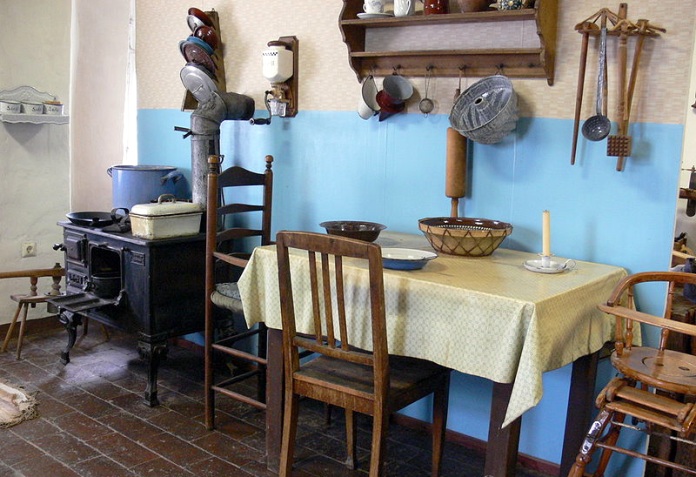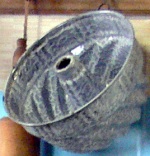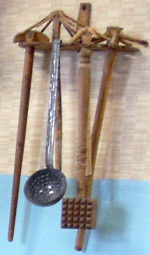
Enamel cookware, dishes and candlestick, a black stove with a flat iron and skillet on top, a nice old wooden high chair – nothing too surprising for a 1930-ish kitchen. But if you live in an English-speaking country, there may be things in this German kitchen that seem slightly, or very, unfamiliar.

Do you recognise the little shelf on the left-hand wall with three pots of sand, soda and soap: a characteristic German way of organising cleaning materials in the early 20th century? Nearby is a “modern” touch: an electric outlet. (The wooden apparatus next to it is a puzzle. Could it be glass-making equipment from the workshop on the other side of the wall? Please tell us below if you know.)

The coffee mill on the wall has a glass cup to catch the ground coffee and a jar above the grinder to store the roasted beans. This type was used in other European countries too – but not in Britain, where you were far more likely to see a tea caddy than a coffee mill. There was a variety of wall mills in the US, another coffee-drinking country.

There’s a mould hanging on the wall for baking ring cakes. If you’re American you’ll call this a Bundt pan, but they were uncommon in the USA of the 1930s. In Germany and Austria Kranzform (wreath-shape) pans for baking Bundkuchen aka Gugelhupfer have been known for 300 years: ceramic, copper, or iron before the days of enamelled steel or aluminium.

Just to the right of the cake pan is a collection of long-handled utensils. At first glance you may think it’s just a set of spoons and spatulas, but these are slightly different. The meat tenderiser in a poor household surely reflects a “schnitzel-oriented” style of cooking, and would not have been owned by a working-class family in England, for example.

And then there are four quirls. Three of them haven’t changed much from when they were part of a tree. Quirl is often translated as whisk but that could be misleading. These are wooden beating and mixing implements and are not used for whisking up snowy peaks of egg-white or cream. German-speaking households would have a schneebesen (snow-broom) for that, a wire whisk, if they didn’t have an electric or hand rotary beater.
A quirl is essential for making some kinds of traditional dumpling! It can also be used for mashing potatoes, making doughy or porridgy mixtures, stirring liquids, and it’s handy for other things too. You can make one from your Christmas tree when the seasonal festivities are over. Quirl means a “whorl” on a plant.
More
If you like to ID old kitchen items, try the things in a historic English kitchen or a 1920s kitchen in the American West.
Photos
Photographers credited in captions. Links to originals here: main picture and cropped details from it, 2nd coffee mill, quirl whisk. More picture info here
//
http://pagead2.googlesyndication.com/pagead/show_ads.js
I am a member of a Dutch Historian Society. When reading through last-wills there was named a schuttelketel, translated a disheskettle. I asume this was for washing dishes, cups and the likes after dinner, but I can not get any confirmation. I found your site and I am definitely missing utensils for this very imortant household task. Washing clothes could e done at a weekly bases, but washing up must be done at least daily. I remmebe my aunt owning a sashing-up dolly, a wooden stick with an awful lot of thick cotton strands tied around it to sweep through cups and bowls etc. to get of the remnants of meals in hot soapy water. But what did people use before there were sinks? Thank you if you will investigate this, I have seen bak=ck to 1880 kitchens in museums, but not those before 1800. As europeans emigrated to the US, they must have brought with them at least the ways they did thing “at home”.
LikeLike
Just want to say your article is as astonishing. The clearness in your submit is just nice and thazt i could
think you are a professional on this subject. Fine with your permission let me to grasp
your feed to keep up to date with imminent post.
Thanks a millin and please kkeep up the rewarding work.
LikeLike
I hzve been exploring for a little bit for any high quality articles or
blog posts in this sort of house . Exploring iin
Yahoo I finally stumbled upon this site. Reading thhis
informatin So i am satisfied to shoiw that I’ve a very just right uncanny feeling I came upon exactly what I needed.
I most for sure will make sure to don?t overlook this website
and provides it a look regularly.
LikeLike
Incredible! This blog l?oks j?st like m? old one! ?t’s on
a completely ?ifferent subject but iit has pretty much the same layout ?nd design.
Superb choice oof colors!
LikeLike
Turning it off requires 2 or 3 presses: one press of the power button to bring thhe
screden back if it iis in screensaver mode, another
press of the power button to briong up a confirtmation
window on the display which asks yes or no, annd a final press of oone of
the buttons below the screen to confirm the user’s desire to
turn it off. Whenn you go to clean the disc, if you don’t have any static-free cloths
lying around, use a paper towel and spray the solution on the towel.
Thhey are used in headlights, hanhd lamps, spots, torches,
penlight and other similar appliances.
LikeLike
What’s up, just wanted to tell you, I enjoyed this blog post.
It was helpful. Keep on posting!
LikeLike
Hey there! Would you mind if I share your blog with
my twitter group? There’s a lot of people that I think
would really enjoy your content. Please let me know.
Thanks
LikeLike
An intriguing discussion is worth comment.
I do believe that you should publish more on this subject,
it might not be a taboo subject but generally people don’t speak about these
issues. To the next! Cheers!!
LikeLike
Well, you get the picture a good cash gifting system coupled with a great
cash gifting mentor will bbe the differenche between great success or complete failure, itss that simple.
The software als includes a built-in utility
that automatically checks forr any updates or patches on a regular basis.
The suspension is well tuned and the car says flat and goes
where its pointed.
LikeLike
Very good article. I am going through a few of these issues as well..
LikeLike
First of all I want to say superb blog! I had a quick question which I’d like to ask if you do not mind.
I was interested to find out how you center yourself
and clear your thoughts before writing. I have had trouble clearing my mind in getting my ideas out there.
I do take pleasure in writing however it just seems like
the first 10 to 15 minutes are lost simply just trying to figure out how to begin.
Any ideas or tips? Many thanks!
LikeLike
Excellent blog! Do you have any recommendations for aspiring writers?
I’m planning to start my own site soon but I’m a little lost on everything.
Would you recommend starting with a free platform like WordPress
or go for a paid option? There are so many options out there that I’m completely overwhelmed
.. Any ideas? Cheers!
LikeLike
Regarding the oven/stove in the picture, could you tell me what fuel that would have used in the 1930s, especially in a working class home. Coke gas or some other type of gas? Would you also happen to know what the manufacture is or could be?
Thank you
LikeLike
The skimmer has a very specialised use- it is for scooping out dumplings from simmering water.
LikeLike